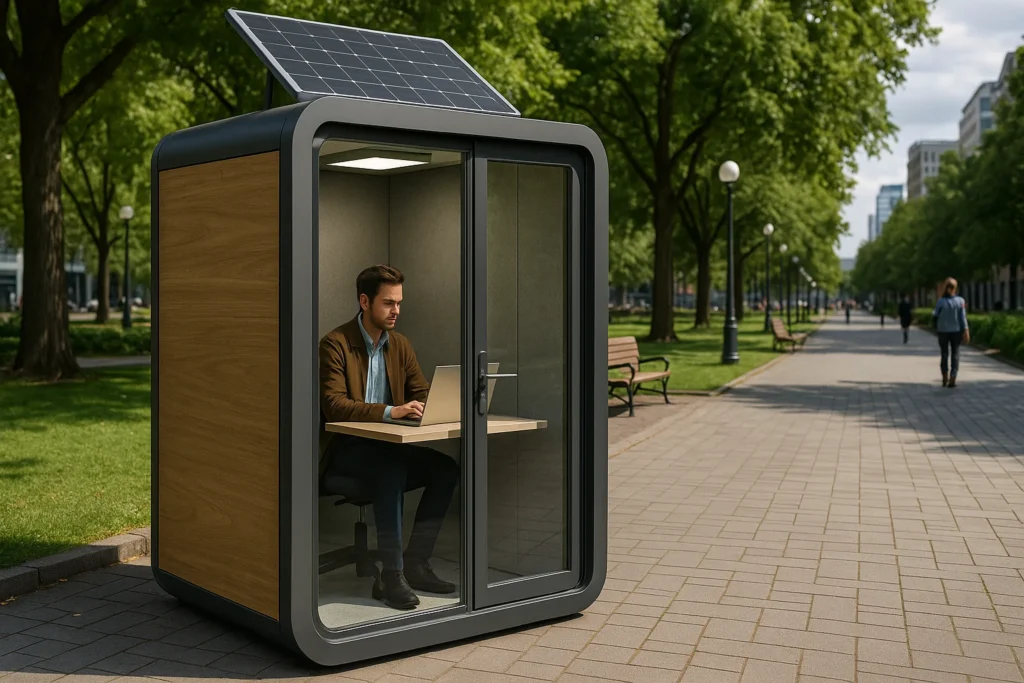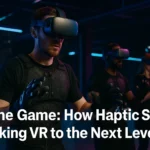Maya sprinted through Grand Central Station’s bustling concourse, heels clacking like a frantic metronome. Lukewarm coffee sloshed dangerously close to her cream-colored blazer. Her 10:30 AM investor call started in 7 minutes, and every café seat overflowed with commuters and tourists. A wave of panic tightened her chest – missing this pitch wasn’t an option. Then, a soft glow caught her eye near the Oyster Bar: a cluster of sleek, egg-shaped pods, their doors shimmering with a subtle digital availability signal. She swiped her phone at a unit labeled ZenPod. With a near-silent hiss, the door slid open, revealing a sanctuary. As she stepped inside, the roar of the station dissolved into profound silence. Her laptop booted instantly onto the built-in 27-inch touchscreen monitor. Climate control hummed to life, setting the perfect temperature. At 10:29 AM, Maya was flawlessly presenting her startup’s future, worlds away from the chaos. This is the new reality defining 2025: Micro-Work Pods – soundproof, solar-powered, AI-connected sanctuaries – transforming parks, plazas, and transit hubs into instant, professional-grade offices for the global mobile workforce.
Beyond the Coffee Shop Chaos: Engineering the Urban Oasis
These aren’t mere upgraded phone booths. Modern urban micro-offices are feats of engineering, packing sophisticated technology into remarkably compact, resilient spaces designed for intense urban environments:
- Fortresses of Silence: Achieving true quiet amidst urban din requires serious tech. Multi-layered construction combines aerogel-infused walls, double-paned acoustic glass with a vacuum layer, and specialized WhisperWall composites. The result? A consistent ambient noise level of 25-28 dB – quieter than a whisper or a rural night – effectively neutralizing shouting tourists, rumbling subways, blaring traffic, and piercing station announcements. It’s an auditory clean room.
- Harnessing the Sun, Minimizing Footprint: Sustainability is core. Roof-integrated, high-efficiency monocrystalline solar panels generate significant power. Smart EcoCharge networks manage pods city-wide, seamlessly switching to grid power only when necessary (e.g., prolonged cloudy days or heavy usage). Ultra-low-energy DC-powered LED lighting, precision HVAC systems, and energy-stingy computing hardware ensure pods operate autonomously for hours. Many units even feed surplus energy back into local grids.
- Your AI Concierge & Guardian: Built-in AI assistants (voice-activated or via touchscreen) transcend simple commands. They learn preferences: “Optimize lighting and acoustics for a confidential video call,” “Find and book a 2-person meeting pod near Bryant Park for 2 PM,” “Extend my current session by 30 minutes automatically,” or “Alert me if my next train platform changes.” Environmental sensors continuously monitor air quality (CO2, particulates), occupancy, and system health, triggering self-cleaning cycles or maintenance alerts.
- Plug-and-Play Professionalism: Connectivity and ergonomics are paramount. Expect blazing Wi-Fi 7 (802.11be) with guaranteed bandwidth, multiple universal USB-C PD ports delivering laptop charging, Qi2 wireless charging pads, ergonomic, breathable mesh chairs with lumbar support, height-adjustable desks accommodating sitting or standing work, studio-grade directional microphones with AI noise suppression, and large 4K touchscreen monitors enabling seamless presentations, video conferencing, or multi-screen productivity without hauling extra gear.
- Hygiene by Design: Contactless entry via dedicated app or RFID card is standard. Between users, automated systems engage: UV-C germicidal lamps bathe the interior surfaces, medical-grade HEPA + carbon filtration scrubs the air, and anti-microbial nano-coatings on high-touch surfaces (desk, chair, controls) inhibit pathogen growth. Usage logs and sanitization timestamps are often visible in the provider’s app for user assurance.
Where Solitude Blooms: Mapping the Pod Ecosystem
Cities worldwide are strategically embedding these productivity pods into high-demand zones, creating networks of accessible workspaces:
- Transit Hub Lifelines: Major intercity train stations (Grand Central Terminal, London St. Pancras, Tokyo Station, Paris Gare de Lyon), airports (dedicated pre-security zones at Singapore Changi T3, Heathrow T5, Seoul Incheon), and bustling subway interchanges (Berlin Hauptbahnhof, Paris Châtelet–Les Halles, Shinjuku Station) are prime locations. Catching up on emails during a 45-minute layover, prepping for a meeting upon arrival, or squeezing in focused work during a long commute becomes effortlessly productive.
- Park Preserves for Focus: Urban green lungs like NYC’s Bryant Park (Podium Pods), London’s Hyde Park (SmartPark initiative), Singapore’s Gardens by the Bay (WorkGrove pods), and Chicago’s Millennium Park (LoopWorks) offer pods nestled amongst nature. These provide an unparalleled environment for creative thinking, deep work, or simply escaping the sterility of traditional offices, boosting mental well-being alongside productivity.
- Downtown Densification Solutions: In crowded central business districts (San Francisco Financial District, London Canary Wharf, Sydney CBD, Toronto Financial Core), pods appear on sidewalks, public plazas, and building forecourts. They serve as crucial overflow space for nearby offices, impromptu meeting points away from crowded lobbies, or quiet havens for consultants hopping between clients.
- Campus Adjacency & Community Hubs: University campuses (NYU Washington Square, USC Village, UCL London) place pods near libraries and quads for students and faculty. Public libraries (Seattle Central Library, Toronto Reference Library) often host pods in lobbies or gardens. Even suburban main streets and community centers are beginning trials, recognizing the need for flexible, professional space outside dense cores.
The “Why”: Solving the Core Pains of the Modern Mobile Professional
The rapid proliferation of rentable work pods directly addresses fundamental challenges faced by millions:
- The Tyranny of Noise and Distraction: Coffee shops are notoriously loud and unpredictable. Traditional coworking spaces often require expensive, inflexible memberships and may be blocks away when you need them now. Pods offer guaranteed, instant, professional quiet on demand, anywhere in the urban fabric.
- Reclaiming Lost Time, Amplifying Productivity: Turn previously dead time – the 90-minute gap between meetings, the delayed train, the early arrival for an appointment – into valuable, billable hours or focused, uninterrupted work. This transforms urban inefficiency into opportunity.
- Professionalism and Privacy Assured: Host confidential client calls, sensitive HR discussions, or high-stakes video pitches without worrying about eavesdroppers or unprofessional backgrounds. The pod is a secure, controlled environment.
- Ultimate Flexibility Without Commitment: No leases, no deposits, no monthly fees. Rent by the minute (typically starting around $0.30-$0.50/min) or in convenient blocks (15/30/60 min) via intuitive apps like PodSpace, UrbanCube, or ZenPod Connect. Pay only for what you use, when you need it.
- Combating Urban Stress & Boosting Well-being: The ability to step into a quiet, controlled, private space amidst urban chaos provides a significant mental health reset. Access to pods in parks adds the proven cognitive and stress-reducing benefits of nature immersion without leaving the city. It’s a micro-vacation for the mind.
Building the Network: Key Players Shaping the Landscape
Several innovative companies are driving this urban infrastructure revolution, each with distinct strengths:
- ZenPod: A dominant US player known for minimalist Scandinavian design, seamless and powerful AI integration (“Zara”), and extensive networks integrated directly into major transit hubs and downtown cores. Their app excels at cross-city pod discovery and booking.
- UrbanCube: Focused strongly on Europe and sustainability, featuring modular designs allowing for 1-person, 2-person, or small meeting configurations. Boasts the highest solar efficiency ratings and partners closely with municipalities on Green City Initiatives. Strong presence in UK, German, French, and Scandinavian cities.
- SoundSpace: Prioritizes ultimate acoustic isolation and superior air quality control, making them the preferred choice in incredibly dense and noisy Asian megacities like Seoul, Hong Kong, Taipei, and Mumbai. Often features advanced biometric entry options.
- City-Led Partnerships: Forward-thinking municipalities like Seattle, Melbourne, Barcelona, and Helsinki are not just permitting pods but actively partnering with providers. They integrate them into public infrastructure plans, leverage data for urban planning, and sometimes offer subsidized rates during off-peak hours to promote accessibility, viewing them as essential public amenities like benches or Wi-Fi.
Facing Reality: The Inevitable Challenges of Pod Life
Despite the transformative convenience, significant hurdles remain for seamless integration:
- The Scarcity Problem: High-demand pods, especially during peak hours (lunch, evening commute), get booked rapidly. While apps show real-time availability and allow booking hours or days ahead, spontaneous use during rush times can be challenging. Strategic booking habits become essential.
- Cost vs. Value Equation: While cheaper per hour than traditional coworking day passes and invaluable for specific needs, frequent, prolonged use can become expensive. Heavy users often gravitate towards provider-specific subscription tiers (e.g., ZenPod Pro) offering significant discounts and booking priority, creating a hybrid model.
- Space Constraints: The core design is for 1-2 people focused on individual or paired work (e.g., interviews, quick collab). Hosting team meetings or workshops requires booking multiple adjacent pods (not always possible) or reverting to traditional meeting rooms. Larger “Meeting Pod” models are emerging but are less common.
- Technology Isn’t Flawless: Like any complex tech, glitches happen. Wi-Fi can occasionally drop (though redundant connections are common), door sensors might malfunction, or the HVAC could act up. Reputable providers invest heavily in 24/7 remote monitoring, rapid-response local maintenance teams, and robust app-based support and compensation policies.
- The Hygiene Perception Gap: Despite rigorous automated sanitization protocols and visible logs, some users remain understandably cautious about shared enclosed spaces. Providers combat this with transparency, optional “hygiene mode” pre-cleaning cycles initiated via app before entry, and sometimes disposable seat covers or wipes provided inside.
- The Urban Space Battle: Finding optimal, permitted, safe, and high-foot-traffic locations in crowded cities is a constant negotiation. Pods compete with bike lanes, outdoor dining, kiosks, and public art for precious sidewalk and plaza space. Municipal permitting processes need to evolve to accommodate this new infrastructure efficiently.
The Future of Fluid Work: Smarter, Healthier, Everywhere
The trajectory points towards deeper integration, enhanced intelligence, and broader applications:
- Hyper-Local, Hyper-Connected Networks: Expect pod density to increase dramatically within dense urban cores, ensuring one is always within a 5-7 minute walk. City-wide integrated apps will show availability across all providers seamlessly.
- Predictive & Proactive AI: AI will evolve beyond reactive commands to predictive assistance: “A pod near your 3 PM meeting location just became available,” “Your usual pod in the park is reserved; alternatives nearby are X, Y, Z,” or “Traffic to your next appointment is heavy; extend your session?” Integration with calendar apps will be key.
- Enhanced Wellness Integration: Future pods may incorporate circadian rhythm lighting that adjusts throughout the day, guided meditation or breathwork sessions accessible via the screen, posture correction alerts via discreet sensors, or even aromatherapy diffusers for stress reduction.
- Multi-Functional Urban Modules: Pods could dynamically adapt based on need: a workspace by day transforms into a private nursing/pumping room, a secure telehealth consultation booth, a small-scale retail pickup point, or even an emergency safety shelter during extreme weather events.
- Expansion Beyond the Core: Look for pods appearing in residential neighborhoods (offering home workers an escape), beach and lakeside promenades, rural towns lacking traditional business infrastructure, and even large corporate campuses as overflow or quiet zones.
- Material & Energy Innovations: Development of self-cleaning exterior surfaces, even more efficient transparent solar cells integrated into glass, kinetic energy harvesting from door mechanisms or foot traffic, and advanced phase-change materials for better thermal regulation without heavy energy draw.
Conclusion: Redefining the Workscape, One Pod at a Time
Maya finished her investor call, the positive feedback still echoing with the promise of a crucial next step. She gathered her things, tapped “End Session” on the touchscreen, and the ZenPod door slid open, releasing her back into Grand Central’s vibrant, swirling energy. The frantic anxiety of her arrival felt distant, replaced by a sense of calm accomplishment. As she walked towards her next meeting, a notification chimed softly on her phone: “Your reserved ZenPod near Bryant Park is ready. Ambient noise: 27dB. Air Quality: Excellent.” A genuine smile spread across her face. Relief wasn’t just avoiding a disaster; it was effortless control.
Micro-Work Pods represent far more than convenient bolt-holes. They signify a fundamental reimagining of urban infrastructure and the nature of work itself. They acknowledge that professional activity is no longer anchored to a fixed desk within a dedicated building. Instead, they create dynamic, on-demand islands of focus and professionalism within the flowing stream of city life. They empower unprecedented flexibility, reclaim lost time, reduce urban stress, and democratize access to high-quality workspaces. While challenges around equitable access, cost management, and urban integration persist, the core value proposition is undeniable: a quiet, connected, professional-grade sanctuary available instantly, almost anywhere, precisely when needed. The future of work isn’t just remote or hybrid; it’s mobile, fluid, resilient, and increasingly powered by the quiet hum of a solar-powered micro-office waiting on your corner, in your park, or at your station. The desk is dead. Long live the pod.



